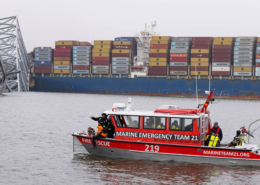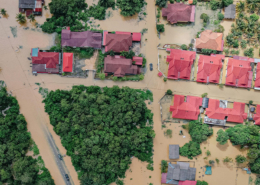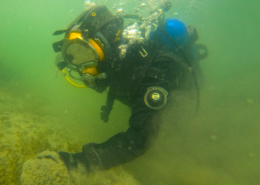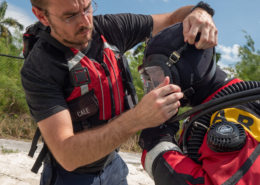The Role of Public Safety Divers in the Legal System
Contributing Authors: Neil Penman, Tanya Chapman, Wes Foster, J.M. Smith, Michael Harper, Thomas Powell
In the modern public safety diver community, we see various types of departments handling dive operations. These departments may be associated with fire-fighting, rescue, emergency management, law enforcement, and various other groups. The reality that must often be faced is that the ability to dive, handle evidence, and operate beyond the realm of “rescue” falls under the purview of law enforcement. In many cases, non-law enforcement dive teams are formed to fill a necessary gap when law enforcement organizations do not have or do not wish to have internal teams. Despite this fact, all dive teams must follow regional laws when performing dive operations, and in many cases, must seek the advice and support of associated law enforcement or justice system personnel. The following are topics associated with public safety diving and the legal system presented by individuals working within the law enforcement community who have experience in public safety diving, training, and operations:
Diving Is Evidentiary In Nature
When diving with a Public Safety Dive Team, there are a few things divers need to remember, especially if you are on a LEO dive team or your team is diving for a LEO department. Keep in mind you are diving on/in a crime scene. This factor means that you or another team member may end up testifying in a court of law. Having said that, documentation is very important in regard to the outcome of any legal case. A clear, detailed report must be completed during and after any type of operation that may involve any type of recovery. The location of any evidence found must be documented, collected, and preserved correctly. Every detail associated with planning, searching, finding, marking, and recovering evidence must be documented to show that the team did its best to protect the collected evidence and present it back to investigators in the best “original” quality possible. This type of documentation establishes that a best-effort was made and that thought went into operational activities. In many cases, a team may wish to reach out to expert individuals who can provide assistance. These experts may include a medical examiner, coroner, or crime scene technician.
The chain of custody must also be maintained. This means the diver who locates the evidence should be the one who collects and then turns the evidence over to the detective in charge of the case whenever possible. Other personnel may be used to assist the primary diver performing the recovery, but a single individual maintaining the quality of evidence assures investigators that information is not lost as more and more people are asked to handle and manipulate items. Again, all actions and information must be documented and recorded to show the legal system the processes used to retrieve evidence.
The diver or divers who locate any evidence should know they will be the ones who will be required to testify in a court of law if requested by an associated attorney. The case may not go to court for several years, so the diver/s should write a report of their own detailing what they did and saw when locating evidence. This action will help them remember what they did and experienced if they are asked to testify years later.
I would suggest taking a class on testifying in a court of law. ERDI has an online course associated with this topic that any public safety diver can gain access to in order to get a better understanding of how a courtroom experience may present. Remember, the better your documentation is the less likely a defense lawyer will be able to find any faults, and the less likely he or she will want you to testify.
Jurisdictional Concerns
While public safety diving is often filled with danger, one aspect in which a margin of safety can be guaranteed is the aspect of jurisdiction. Public safety divers must consider their legal authority and responsibility when responding to potential crime scenes. Clearly, law enforcement officers should be aware of their jurisdictional restrictions and the actions considered appropriate for them to take based on their agency’s policy. However, for public safety divers who are not law enforcement officers the issue of jurisdiction may be a bit more unclear.
Emergency personnel responding to a request for assistance at the scene of criminal activity must identify the agency which has jurisdictional authority over the crime scene. The jurisdictional authority should have an incident commander onsite. Onsite command and control may evolve during the incident based on the immediate needs and goals to be accomplished. Authority of a crime scene is fluid based on what is occurring with the scene at that moment. If the possibility exists for the rescue of a live person, then fire department personnel and/or emergency medical service personnel may be functioning in the incident commander role. If the incident has progressed to an evidentiary recovery mode, then typically law enforcement will assume primary operational jurisdiction from that point forward unless an additional emergency occurs onsite.
Cooperation from each agency operating at a crime scene is paramount. Respect for personnel roles and the duties associated with each should be clearly defined, removing questions of responsibility. Ideally, evidentiary items would be recovered by law enforcement personnel due to their experience with judicial proceedings. However, this is not always feasible. In those instances, law enforcement and/or the district attorney’s office should work with the individual recovering evidence prior to court proceedings to ensure their comfort and competence in providing testimony.
Joint training between agencies will facilitate first responders becoming familiar with the requirements and procedural standards utilized in the recovery of evidential items. Agency crime laboratories require specific collection and evaluation techniques. As a result, the method of recovery, packaging, and examination will vary. The successful collection and processing of evidentiary items is based on the demands of the jurisdiction in which the collection occurs. To ensure viability of potential evidence in judicial proceedings, public safety divers and emergency response divers should integrate their actions and strive for compliance.
Jurisdictional boundaries may appear obvious until an actual incident occurs. However, in the moments of an emergent situation, those boundaries tend to blur. Proactive actions taken by all potential responders may remove confusion and concern in advance based on providing those involved with adequate training and mutual aid agreements. ERDI courses promote the successful integration of emergency personnel in a team-centric curriculum ensuring mutual respect, delegation of duties, delineation of roles, and recommendations on proper procedures to be followed in compliance with accepted standards.
Legal Rights to Dive
For those of us in public safety diving, one of our primary missions is the recovery of items that may be evidentiary in nature. As such, we may be recovering numerous types of “items,” such as human remains, vehicles, weapons, stolen property, etc. We respond to the scene and are required to treat each individual scene as a crime scene until we can prove it is not evidentiary in nature. This puts the burden squarely in our lap.
At this point, we must go back to the basics – the Fourth Amendment. The Fourth Amendment of the U.S. Constitution provides that “[t]he right of the people to be secure in their persons, houses, papers, and effects, against unreasonable searches and seizures, shall not be violated, and no Warrants shall issue, but upon probable cause, supported by Oath or affirmation, and particularly describing the place to be searched, and the persons or things to be seized.”
The ultimate goal of the Fourth Amendment is to protect people’s right to privacy and freedom from unreasonable intrusions by the government. However, the Fourth Amendment does not guarantee protection from all searches and seizures, but only those done by the government and deemed unreasonable under the law.
To claim violation of Fourth Amendment as the basis for suppressing relevant evidence, the court had long required that the claimant must prove that he himself was the victim of an invasion of privacy to have a valid standing to claim protection under the Fourth Amendment. However, the Supreme Court has departed from such requirement. Currently, exclusion is determined by questioning whether or not the claimant’s Fourth Amendment rights have been violated. This answer, in turn, then requires that the claimant demonstrates a justifiable expectation of privacy, which was arbitrarily violated by the government.
In general, most warrantless searches of private premises are prohibited under the Fourth Amendment unless specific exceptions apply. Exigent circumstances exist in situations such as Search Incident to Arrest, Fleeting Targets Search, Officer Safety Search, Booking Search, Inventory, and Special Needs Searches.
On the other hand, warrantless search and seizure of properties are not illegal if the objects being searched are in plain view. Further, warrantless seizure of abandoned property or of properties on an open field do not violate Fourth Amendment because it is considered that having expectation of privacy right to an abandoned property or to properties on an open field is not reasonable.
In some states there are some exceptions to this limitation where some state authorities have granted protection to open fields. States can always establish higher standards for searches and seizures protection than what is required by the Fourth Amendment, but states cannot allow conducts that violate the Fourth Amendment.
However, the protection under the Fourth Amendment can be waived if one voluntarily consents to or does not object to evidence collected during a warrantless search or seizure.
All of that being said, let’s discuss what types of “public safety dive teams” can actually dive for and recover items that may be considered evidence.
Local public safety agencies should collaborate and discuss the level of experience, training, and equipment each participating agency has. Public safety dive teams are not just comprised of law enforcement agencies. Some fire and EMS units have PSD teams also. No matter what agencies comprise your team, each individual diver must be trained and certified in the proper manner for locating and recovering items, along with any documentation that accompanies it. Simply locating an object, grabbing it, and bringing it to the surface (if possible) will most likely have a negative impact on the item being admitted as evidence in court proceedings. You must recognize the fact that many of the management or administrative personnel, in general, may not have much knowledge about scuba diving. To that, they must be provided with background and additional information so they may understand that there are OSHA and NFPA regulations in place for divers in a workplace environment. Once again, Public Safety Diving is not recreational.
The final judgment on who can search for and locate possible items of evidence should be a major point of discussion – in advance – between the agency having jurisdiction (AHJ) and the judicial agency responsible for prosecution. This would include meetings between agencies such as local, county, and state law enforcement agencies along with District Attorneys, Solicitors, or Prosecutors. These meetings should evolve into Memorandums of Understanding or Mutual Aid Response Agreements.
Several articles have discussed the need for advanced training on public safety diving, including underwater crime scene investigations, along with the proper documentation for each item located. Each item recovered must be recovered in the proper manner to ensure that it can be used in court at a later date. Without the properly trained public safety dive team, items recovered from a location may be excluded at trial if the defense attorney is able to argue that the team did not have the proper training to perform the search and recovery.
Consent to Search
As a public safety diver and a full time sworn law enforcement officer currently assigned as an Investigator in the state of NC, I have experienced unique challenges in my 15 years on the Sheriff’s Office Search and Recovery Team here in Durham, NC. First and foremost, this team has been in existence since 1983 in Durham and, for the longest time, was one of only a handful of dive teams in the state of NC. We all know that public safety diving consists of law enforcement, fire, EMS, and volunteer teams. The challenges to consider first and foremost are that the primary functions of public safety diver teams are traditionally evidence and body recoveries. The argument that has been debated time and time again is that teams other than law enforcement do not receive training in court room testimony, chain of custody, and evidence collection. Another area is the right to search for that evidence or body if it is on private property.
Luckily, even in just the 15 years I have been a public safety diver, these issues have become less of a hot issue because of the push to standardize certifications for divers and their teams. This has been done in order to more efficiently work together and work the same, whether it is a fire department team or a law enforcement team, by incorporating training on legal considerations with a search and evidence collection/underwater crime scene investigations. With open lake or river areas in your specific jurisdictions it is not a big problem with the searches especially around here where the waterways are generally controlled by the US Army Corps of Engineers or NC Department of Natural Resources/State Parks etc.
The legal considerations in regards to collection and recoveries becomes more of a slippery slope when you have to traverse private property to get to an area or the search/recovery operation is in a body of water on private property. Generally, the rule of thumb is when in doubt get a search warrant to enter the property and access the body of water for the search, especially if the recovery of evidence or a body is such that it is classified as a suspicious death or homicide. Open-land areas are an exception that we run into quite often in the realm of SAR operations and no consent or search warrant is required. However, if time is of the essence and the time taken to draft, apply, and obtain signature on a search warrant would harm or destroy the recovery, consent is then just as good as the search warrant. The key thing to remember, just like with all operations, is documentation. Make sure that you identify the proper ownership or control of the area and then get a statement with a signature if a standard form is not available. In my experiences, this has not been a problem as most property owners are more than willing to allow public safety divers to conduct operations and those that aren’t are usually the focus of the investigation in which case the Investigator assigned has already secured a search warrant for the dive team.

Sample Consent to Search Form currently used by Durham County Sheriff’s Office
Fruits of the Poisonous Tree Doctrine
Establishing the proper documentation, collection, storage, and chain of evidence is one of the most critical areas in law enforcement. Evidence policy and procedures, or lack thereof, have been the exaltation or downfall of many good law enforcement professionals and even entire agencies. So when it comes to the added stress of being a public safety diver, evidence policy should be a top priority. When it comes to the fruit of the poisonous tree philosophy, I can think of no better example to use than with public safety diving and law enforcement.
You see, it is one thing to walk into a residence, place of business, etc. and utilize proper evidence handling procedures for a homicide. It is a completely different animal to do so in a body of water when the only ones certified to enter are yourself and your partner, both being public safety dive professionals. You can be most assured that there will be a defense attorney to argue how you, being all alone with the crucial piece of evidence, did not alter it in any way possible. This is the one piece of evidence that will prove or disprove their client’s innocence. That is how it will be looked upon at trial. If we can barely trust our law enforcement public safety dive professionals with what we can see in an open air environment, then how can we trust them in black water conditions with no other personnel there to observe their actions? Thus the fruit of the poisonous tree comes to fruition.
Well, how then can you overcome such criticism and scrutiny? The answer is simple – establish flawless evidence policy and procedures and train everybody in said policy and procedures constantly. Establish a tandem system in which no single person has sole responsibility of collecting and storing evidence. Of equal importance too, take copious notes of everything you find and have excellent writing skills. The old saying goes: If you didn’t write it down, it didn’t happen.” Document everything!! It is not worth rushing to write stuff down just so you can leave sooner. When it comes time for court, which could be a minimum of months to years down the line, you will not remember some scribble; only detailed, well written and laid out notes of the evidence are what will save you. Too many cases are lost due to this “technicality” when all that was needed was to have a proper chain of evidence and collection procedures. It will be much harder when you’re in a lake, river, pond, etc. to do so, but it is well worth it. I can even attest that when you have shown yourself to be thorough in your evidence procedures and documentation, you have that much more credibility in the courtroom. For the sake of the entire case, don’t go through the ordeal of putting your life on the line by diving in hazardous and unknown situations for a case just to have it thrown out because of evidence. You owe it to yourself, your partner, the victim, and to the citizens we have sworn to protect.
What have we learned through each of these discussions? First and foremost, we must document everything we do when it comes to public safety diving. If we are going to behave this way when we arrive on active scenes for operations, we must also train this way at all times. This means that during our “in-service” training days, we must entertain the process of filling out paperwork, following the rules we are taught, and never skipping policies found in departmental standard operating guidelines.
The current industry standard is that law enforcement personnel are the individuals trained to handle and collect evidence. When a resource consisting of sworn law enforcement people is not available, the associated law enforcement agency may request outside assistance from a different type of department. To establish comfort and trust, departments of all types must begin to work, train, and operate together when appropriate. Essentially, these factors are justification for mutual aid agreements and training side-by-side. If a fire dive team invites local law enforcement personnel to training days, the law enforcement investigators will better understand how the dive team functions, provide insight and corrections (regarding evidence) as needed, and develop trust in the capabilities of the non-sworn individuals they may ask to collect subsurface evidence.
The key to good public safety diving seems to fall into the realm of constant training. If you keep learning, improving education, elevating skill levels, and gaining insight from others, the abilities of your team will grow. When we train, we must treat scenarios as active scenes and avoid cutting corners. Actions may take longer if we never cut corners, but on scene we will be better prepared to follow muscle memory, protect each other, behave and operate in a safe fashion, and accomplish the mission at hand.


 Photo By: Defense Visual Information Distribution Service
Photo By: Defense Visual Information Distribution Service


 Y. ZIN
Y. ZIN


Hinterlasse einen Kommentar
An der Diskussion beteiligen?Hinterlasse uns deinen Kommentar!